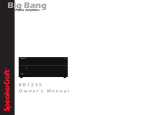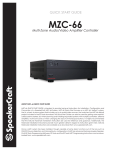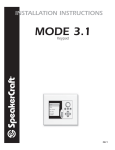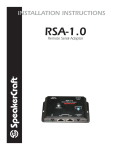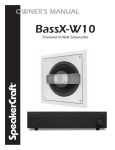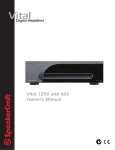Download BB835 Manual.qxd - Tech Source Distributors
Transcript
Big Bang SpeakerCraft ® Power Amplifiers BB835 O w n e r ’s M a n u a l Thank you for purchasing the SpeakerCraft BB835 power amplifier. The BB835 contains the excellent performance and reliability that SpeakerCraft products have been recognized for. The BB835 features the flexibility needed for demanding custom installation applications. It is ideal for use in home theater, stereo, multi-room, multizone and commercial applications. For best performance, please carefully read the instructions in this manual. Table Of Contents Page Features FEATURES Audiophile Design Sophisticated design and superior internal components result in outstanding sound quality, performance and long term reliability. Advanced Protection Each channel is individually protected. If the circuitry determines that a channel must be shut down for protection, a rare occurrence, only the channel affected will be turned off. The other channels will continue to play. Once conditions return to normal, the affected channel will be turned back on and operate as normal. 2 Flexible Input Selection Front Panel Diagram 3 Each of the 12 channels can be assigned a variety of source inputs. A dedicated input can be assigned to each channel. Each channel can also be configured to play common signals from the Bus or Auxiliary inputs. This provides the flexibility needed in sophisticated custom audio installations. Rear Panel Diagram 5 Bridging System Design & Operation Considerations 7 System Design Examples 9 The power output of adjacent channels can be combined to provide extra power when needed in certain areas. This is easily accomplished by flipping a single switch. Individual Channel Level Adjustments Installation Considerations 19 Each channel has its own level adjustment. This allows the loudness of each speaker to be perfectly matched to its area. Installation 20 InstaLLock™ Connector Outputs Simplify the connection of the speaker outputs by using SpeakerCraft’s InstaLLock™ Connector, purchased separately. InstaLLock™ Connectors eliminate the hassle of connecting multiple wires onto the back of the amplifier. Instead they can be easily connected to the InstaLLock™ Connector which is later plugged into the back of the amplifier. InstaLLock™ Connectors can be purchased from your SpeakerCraft Dealer. Operation 24 Troubleshooting 25 Specifications 27 Multiple Power Modes and Output Trigger 28 There are three ways to turn the amplifier on: constant, trigger and audio sense. This allows the amplifier to operate seamlessly as part of a sophisticated custom installation. A separate output trigger allows the amplifier to activate other components via a voltage trigger. Warranty 1 2 Diagram 1 - Front Panel Active LED indicates that the amplifier is working. Master power switch. Turns off power to amplifier and Power Mode Circuitry. Protection LEDs indicate that either a fault in the wiring, the speaker, or the amplifier has caused the amplifier to shut down. 3 4 Diagram 2 - Rear Panel Main bus inputs allow outputs from receivers, CD players, TVs, or any stereo audio sources to be amplified across all channels for easy multiroom applications. Auxiliary inputs allow an additional audio source to be played on any channel that is switched to AUX. Bus outputs allow the bus inputs to be sent to other amplifiers or a daisy chain without the need for ‘Y’ cables or splitters. Auxiliary outputs allow you to daisy chain the input to other audio sources. Level controls for each channel. Bridging switch allows you to easily double the power output by coupling two channels together. Gold plated individual channel inputs allow you to connect different audio sources to each channel. One switch allows you to select which stereo Input Selection input channel will play switch allows you through the speaker outto select between puts: left, right, or left the common bus and auxiliary inputs, and right combined. If switched to Left + Right, or the individual both input channels are channel input. combined. Impedance switch is used to select either 8Ω or 4Ω. The Power Mode switch is used to toggle between three different trigger methods to power up the amplifier. 3-30V A/C or D/C input to trigger power up with voltage from another device, such as a receiver. 12V output to turn on other devices when amplifier is powered up. Connect to projector screens, powered drapes, or other devices with voltage triggers. 5 Binding posts allow the use of stripped speaker wire, spade connectors, or banana plugs. 3-Prong removable power plug. Fused AC input. Plugs for InstaLLock™ connectors are provided for easy connection of speaker outputs. Requires optional InstaLLock™ amplifier connectors to be purchased separately. 6 SYSTEM DESIGN & OPERATION CONSIDERATIONS To best understand system design and operation of the BB835 it is useful to understand the following terms and features as they relate to the BB835. Bus Input Allows the signal from a source to be distributed to any of the 12 channels on the amplifier. Auxiliary Inputs Multi-Room A system design that plays the same source at the same time in all rooms. If a change is made in one room, the same change takes place in all other rooms. For example, if a listener changes from CD to Tuner in the bedroom, the same change will be heard in the kitchen. Note: With the use of volume controls or speaker switchers the volume of each room can be controlled separately of the other rooms. Allows a the signal from a secondary source to be distributed to any of the 12 channels of the amplifier. Impedance Switch Select either 8Ω or 4Ω to maximize amplifier performance with a variety of speaker loads. See the sections titled “Selecting the Impedance Setting” and “Selecting Bridge Mode” in the “Installation” section for proper setting of this switch. Multi-Zone A system design that allows different sources to be played in each room. A change in one room can be made without changing the other rooms. For example the CD player can be heard in the bedroom while the kitchen is playing the tuner. Bridging Power Mode Selection There are three ways to turn the amplifier on and off. Use the following list to decide which mode will work best for your application. See Diagram 3 below. 1. Constant The combining of 2 channels to create one mono channel. It is useful when more volume is needed in a particular area. Source Use this selection when you wish to manually turn the amplifier on and off by using the front mounted power button. 2. Trigger Component, audio or video, that provides an audio signal. Examples are CD, VCR, DVD, tape deck and tuner. The source provides the audio information that is amplified by the BB835. Channel A distinct unit of the amplifier that provides output to one speaker. On the BB835 the input to each channel can be configured to select from the BUS INPUT, the AUX INPUT or that channel’s unique CHANNEL INPUT. Two adjacent channels can be bridged to provide higher power to one speaker. Level Controls Allows any of the channels to be adjusted independently to raise or lower the output of each channel. This may be used to control the speaker output in order to balance different rooms or areas of the system. Use this selection if you wish the amplifier turn on when it receives voltage (3-30V A/C or D/C) from an external source and turn off once that voltage has stopped. Some components have voltage outputs that are designed for this use. In addition there are devices that can be used as part of an automated system that will provide voltage to enable the mode. The voltage source must be connected to the trigger-input jack on the back of the amplifier. 3. Audio Sense Use this selection when you want the amplifier to turn on when the amplifier’s main input receives an audio signal. At the moment that either the left or right input jacks receive a signal the amplifier is turned on. Once the signal stops the amplifier waits 3 minutes and then turns off. Diagram 3: BUS*AUX*LINE Switch Allows each channel to play a variety of different inputs. Depending on the switch position the channel amplifies the signal connected to the BUS input, the AUX input, or its own LINE input. R R+L L Switch When either a BUS or AUX input is selected, this switch is used to direct the channel to play the left signal from the input “L” or the right signal from the input “R”, or a combined right and left signal from the input “R+L”. 7 8 SYSTEM DESIGN EXAMPLES There are many ways to configure the BB835 amplifier. The following pages contain some typical installation examples. Use these examples to generate ideas for your system design. Multi-Room Installation Example (Diagram 4) This illustrates the simplest use of the BB835, distributing audio throughout the home. In this example only one source can be selected at a time, all pairs of speakers have the same audio signal available. The Input Selection switch is set to “BUS” on all channels. Adjacent channels are assigned left and right. Multi-Zone Example #1 (Diagram 5) This illustrates the simplest way to provide an audio signal to one area that is independent of the main audio signal. Zone 2 uses a CD player connected to just that Zone. The rest of the system operates Zone 1 and is connected to the preamplifier / receiver. The Input Selection switch on channels 1-10 is set to “BUS” with adjacent channels assigned left and right. The Input Selection Switch on channels 11 and 12 are set to “LINE”. Multi-Zone Example #2 (Diagram 6) This illustrates the ability to listen to different audio signals in each zone, independent of every other zone. The system relies on a multi-zone preamplifier or up to 6 independent preamplifiers. The Input Selection switch on each channel is set to “LINE” Home Theater / Multi-Room Example (Diagram 7) This configuration allows the user to access the sources connected to a home theater receiver for use in a multi-room installation. It relies on the home theater receiver having a multi-room or similar output. The Input Selection switch on each channel is set to “BUS” with adjacent channels assigned left and right. 9 10 Diagram 4 - Multi-Room Installation AUDIO SOURCES OUTPUT PREAMPLIFIER / RECEIVER OUTPUT DVD INPUT L R L TAPE INPUT L R CD Player R CD INPUT L R OUTPUT L L Tape Deck R R OUTPUT L DVD Player R Room 1 Room 2 VOLUME CONTROL LEFT SPEAKER 11 RIGHT SPEAKER Room 3 VOLUME CONTROL LEFT SPEAKER RIGHT SPEAKER ER Room 4 VOLUME CONTROL LEFT SPEAKER RIGHT SPEAKER VOLUME CONTROL LEFT SPEAKER RIGHT SPEAKER 12 Diagram 5 - Multi-Zone Installation #1 SOURCES SO OUTPUT T PREAMPLIFIER / RECEIVER OUTPUT AUX INPUT L R L DVD INPUT L R TAPE INPUT L R CD Player #1 R CD INPUT L R OUTPUT T L L Tape Deck R R OUTPUT T L CD Player #2 DVD Player R OUTPUT L R VOLUME CONTROL LEFT SPEAKER RIGHT SPEAKER VOLUME CONTROL LEFT SPEAKER RIGHT SPEAKER VOLUME CONTROL VO LEFT SPEAKER VOLUME CONTROL RIGHT SPEAKER LEFT SPEAKER ZONE 1 13 RIGHT SPEAKER ZONE 2 14 Diagram 6 - Multi-Zone Installation #2 DVD Player CD Player OUTPUT AUDIO SOURCES OUTPUT OUTPUT L L L L R R R R 4 STEREO PREAMPLIFIERS OR MULTIZONE PREAMPLIFIER VOLUME CONTROL LEFT SPEAKER RIGHT SPEAKER ZONE 1 15 Tape Deck Tuner OUTPUT CD INPUT DVD INPUT INPU TUNER INPUT TAPE INPUT ZONE 1 OUTPUT L R ZONE 2 OUTPUT OUTP L R ZONE 3 OUTPUT L R ZONE 4 OUTPUT L R VOLUME CONTROL TROL LEFT SPEAKER RIGHT SP SPEAKER E2 ZONE VOLUME CONTROL LEFT SPEAKER RIGHT SPEAKER ZONE 3 VOLUME CONTROL LEFT SPEAKER RIGHT SPEAKER ZONE 4 16 Diagram 7 - Home Theater/Multi-Room Installation SOURCES OUTPUT L HOME THEATER RECEIVER SPEAKER OUTPUTS LEFT CENTER RIGHT SUBWOOFER OUTPUT REAR LEFT MULTI-ROOM OUTPUT L R REAR RIGHT VCR INPUT L R DVD INPUT L R CD Player R CD INPUT L R OUTPUT L DVD Player R OUTPUT L R LEFT SPEAKER REAR LEFT SPEAKER CENTER SPEAKER SUBWOOFER RIGHT SPEAKER REAR RIGHT SPEAKER Room 1 Room om 2 VOLUME CONTROL LEFT SPEAKER 17 RIGHT SPEAKER Room 3 VOLUME CONTROL V LEFT FT SPEAKER RIGHT SPEAKER Room 4 VOLUME CONTROL LEFT SPEAKER RIGHT SPEAKER VOLUME CONTROL LEFT SPEAKER 18 RIGHT SPEAKER VCR Placement INSTALLATION CONSIDERATIONS INSTALLATION CAUTION: All connections and switching must be done with the amplifier’s master power switch positioned to “off”. DO: • Place the amplifier with the feet resting on a solid flat level surface. • Place the amplifier in a well-vented area to provide proper cooling. In areas that lack proper ventilation, such as tight cabinets or racks, it may be necessary to install small fans to create air movement. DON’T: • Don’t block the ventilation holes on the top or bottom of the amplifier. Never place it on carpeting or similar material. • Don’t place the amplifier in any other position other than horizontal with the feet down. Never place on its side or resting on the back where the terminals are located. • Don’t the amplifier near heat sources, or in an area that it would be exposed to moisture. Select the Power Mode Selection Refer to the Power Mode Selection area under installation considerations to determine which setting to use to turn the amplifier on. Once you have determined which mode you will be using set the switches as outlined in the following chart: Selection Switch Settings Mode Constant Power Mode Selection = Set to “Constant”. Master Power Button = Push to “In” position to turn amplifier “On”, out position is “Off”. Will light up when the amplifier is “On/Active” and will go off when it is “off”. Trigger Power Mode Selection = Set to “Trigger”. Master Power Button = Leave in the “On” position (Button in). Will light up only when the amplifier receives a voltage indicating the amplifier is “On/Active”. Will turn off once the voltage has stopped. Audio Sense Power Mode Selection = Set to “Audio Sense”. Master Power Button = Leave in the “On” position (Button in). Will light up only when the amplifier receives an audio signal to the main inputs indicating the amplifier is “ON”/active. Will turn off three minutes after the signal has stopped. YOU SHOULD KNOW • The power supply is very large and therefore may cause a hum to be heard in some components if they are placed very close to the amplifier. 19 Active Light 20 Selecting Inputs (See Diagrams 8 & 9) Each channel is capable of delivering the source from many inputs. The three main inputs are BUS, AUX and LINE IN. The selection for these inputs is done via the Input Selection switch, marked “BUS-AUX-LINE”. To select a source for each channel, follow the steps below: 1. Select the desired source input. Set the Input Selection switch to BUS (will play source connected to the BUS INPUT), AUX (will play source connected to the AUX INPUT) or LINE (will play source connected to the LINE IN). Diagram 8 Selecting Bridge Mode (See Diagram 11) Under normal operation, this should be left in the 8 ohm position as illustrated in Diagram 10. It is sometimes desirable to combine two channels into one through bridging. The output of the combined channels can then be used to power one speaker. To bridge two adjacent channels first make sure that the Impedance Switch is in the 8ohm position. Next move the switch marked “BRIDGE” to the “ON” position. The speaker must be connected to the terminals immediately under the “BRIDGED” text as indicated in Diagram 11. All input selection and settings for the bridged channels will be done on the channel to the left. Do not connect more than one speaker to the outputs of the bridged channel. 2. The BUS and AUX inputs each have a left and right input. The left, right or combined left and right signal from these may be selected via the switch marked “R R+L L”. Select the side you want the channel to deliver. Selecting “R” will play the right channel of the selected input. Selecting “L” will play the left channel of the selected input. Selecting “R+L” will play the combined signals of right and left. Diagram 11 Diagram 9 To “ON” Position Select the Impedance Setting (See Diagram 10) CAUTION: The switch must always be set to 8Ω if the adjacent channels are bridged. Leave in 8Ω Position For best results, if you will be using multiple speakers that will make the overall system impedance load drop to below 4 ohms at any pair of outputs, make sure that the switch above the speaker inputs is in the 4 ohm speaker setting. If the system impedance load will not drop below 4 ohms, leave it in the factory setting of 8 ohms. Diagram 10 21 (+) (-) Wires to Speaker 22 Control Output Connecting the Line Level Audio Inputs The 12V output jack on the back of the amplifier can be used to turn on a variety of components equipped to be activated when they receive a 12V DC output. Voltage is only delivered to the jack when the amplifier is “on” or active. When the amplifier turns off, the voltage ceases. CAUTION: Only make connections when the amplifier is turned off. Before connecting another device to the 12 output please make sure that the device can accept 12V DC at 150ma. To connect the output to another device you must access the output jack with a two-conductor plug that fits into the 3.5mm jack. Be aware that the tip of the plug will be (+). If you are unsure about using this feature please contact an authorized SpeakerCraft dealer for assistance. Connecting the Speaker Wires CAUTION: Only make connections when the amplifier is turned off. Using Standard Connections (See Diagram 12) For best performance use high quality speaker cables. The banana plug outputs on the back of the amplifier allow for a variety of ways to connect your speakers to the amplifier. Diagram 12: Binding Post Detail There are three areas that an input signal can be connected, BUS, AUX and LINE IN. Refer to the System Design Examples to determine which is best suited for your application. Audio Outputs Sources connected to the “BUS” or “AUX” inputs can be forwarded to other components or amplifiers by connecting to the corresponding output sections to the right of each input section. By using standard audio patch cables, you can connect these outputs to the inputs of another amplifier. Up to 5 SpeakerCraft amplifiers can be daisy-chained together. AC Power Plug the socket of the AC cord supplied with the amplifier into the receptacle on the rear of the amplifier. Plug the 2 prong plug directly into a 120V 60 Hz wall outlet. CAUTION: Do not plug the amplifier into the preamplifier or receivers switched outlet. If you wish to have the amplifier turn on once the preamplifier or receiver is activated, use one of the turn on modes, voltage or audio. OPERATION See Diagram 1 for the location of the following: Power Switch The switch marked “Power” on the front panel of the amplifier will turn off all amplifier circuitry no matter which turn on mode is selected. Refer to the “Power Mode Selection” section for further information. Active LED When lit, the Active LED indicates that the amplifier is operating. Refer to the “Power Mode Selection” section of this manual for further information. Protection LEDs Using InstaLLock™ Connector (purchased separately) The InstaLLock™ Connector designed for use with SpeakerCraft Amplifiers must be used. The InstaLLock™ Connector designed for SpeakerCraft Speaker Selectors is not labeled for use with the amplifiers. Please follow the instructions included with the Connector. 23 When lit the “Protection” LEDs located on the front of the amplifier indicate that either a fault in the wiring, the speaker, or the amplifier has caused the channels associated with the LED to shut down. Level Adjustment Knobs The level adjustment knobs on the back panel of the amplifier can be used to adjust the level of each channel. There are many reasons for needing to adjust the level. You many wish to closely match other levels in the system, or you may wish to limit the volume level in an area, such as a child’s room. 24 TROUBLESHOOTING The Problem Possible Causes And Solutions The amplifier is designed to function trouble-free. Most problems occur because of operating errors. If you have a problem please check the troubleshooting list first. If the problem persists, contact your authorized SpeakerCraft dealer or SpeakerCraft customer service at (800) 448-0976. No sound is heard on one or some channels. (Continued) The level adjustment on the channel is turned all the way down. Turn it clockwise to raise the volume. Some or all of the internal fuses are blown. Return the amplifier to your SpeakerCraft dealer for servicing. The Problem Possible Causes And Solutions No sound is heard on all channels. Audio cable to the source component is not connected properly or the cable is bad. Use another cable that you know is good. Hum or buzzing sound is heard. The sound may be caused by a ground loop in the system. Try to eliminate this by reversing the AC plugs of other components in the system. Other causes include faulty cables. The Input Selection switch is positioned incorrectly. Refer to installation instructions for proper settings. Some or all of the internal fuses are blown. Return the amplifier to your SpeakerCraft dealer for servicing. No sound is heard on one or some channels. Amplifier will not turn on. The amplifier must be plugged into a live outlet. The power switch on the front panel must be on. The Power Mode switch may be positioned incorrectly. Audio cable to the source component is not connected properly or the cable is bad. Use another cable that you know is good. The Input Selection switch is positioned incorrectly. Refer to installation instructions for proper settings. The Bridging switch is positioned incorrectly. Refer to installation instructions for proper settings. Check the termination points of the speaker cable at both the amplifier and speaker. If using InstaLLock™ Connector, check the connections at the levers. A speaker is not working. Make sure by connecting the channel to a speaker that you know to be working. (Continued on next page.) 25 26 SPECIFICATIONS BB835 WARRANTY Power Output: 35 Watts per channel RMS at 8 ohms (all channels driven) Limited Two-Year Warranty Input Sensitivity: 900mV for 8 ohm rated output Input Impedance: 15K ohms Total Harmonic Distortion: .04% 20Hz to 20kHz @ 8 ohms (all channels driven) SpeakerCraft Inc. warrants to the original retail purchaser only that this SpeakerCraft product will be free from defects in materials and workmanship for a period of two years, provided the product was purchased from a SpeakerCraft Authorized Dealer. Defective products must be shipped, together with proof of purchase, prepaid insured to the SpeakerCraft Authorized Dealer from whom they were purchased, or to the SpeakerCraft factory at the address listed on this installation instruction manual. Freight collect shipments will be refused. It is preferable to ship this product in the original shipping container to lessen the chance of transit damage. In any case, the risk or loss or damage in transit is to be borne by the purchaser. If upon examination at the Factory or SpeakerCraft Authorized Dealer it is determined that the unit was defective in materials or workmanship at any time during this warranty period, SpeakerCraft or the SpeakerCraft Authorized Dealer will, at its option, repair or replace this product at no additional charge, except as set forth below. If this model is no longer available and can not be repaired effectively, SpeakerCraft, at its sole option may replace the unit with a current model of equal or greater value. In some cases where a new model is substituted, a modification to the mounting surface may be required. If mounting surface modification is required, SpeakerCraft assumes no responsibility or liability for such modification. All replaced parts and product become the property of SpeakerCraft Inc. Products replaced or repaired under this warranty will be returned to the original retail purchaser, within a reasonable time, freight prepaid. This warranty does not include service or parts to repair damage caused by accident, disaster, misuse, abuse, negligence, inadequate packing or shipping procedures, commercial use, voltage inputs in excess of the rated maximum of the unit, or service, repair or modification of the product which has not been authorized or approved by SpeakerCraft. This warranty also excludes normal cosmetic deterioration caused by environmental conditions. This warranty will be void if the Serial number on the product has been removed, tampered with or defaced. This warranty is in lieu of all other expressed warranties. If the product is defective in materials or workmanship as warranted above, the purchaser’s sole remedy shall be repair or replacement as provided above. In no event will SpeakerCraft be liable for any incidental or consequential damages arising out of the use or inability to use the product, even if SpeakerCraft Inc. or a SpeakerCraft Inc. Authorized Dealer has been advised of the possibility of such damages, or for any claim by any other party. Some states do not allow the exclusion or limitation of consequential damages, so the above limitation and exclusion may not apply. All implied warranties on the product are limited to the duration of this expressed warranty. Some states do not allow limitation on the length of an implied Warranty. If the original retail purchaser resides in such a state, this limitation does not apply. 27 28 940 Columbia Ave., Riverside, CA 92507-4492 (800) 448-0976, Fax (951) 787-8747 www.speakercraft.com SpeakerCraft ® LIT 9/00

















